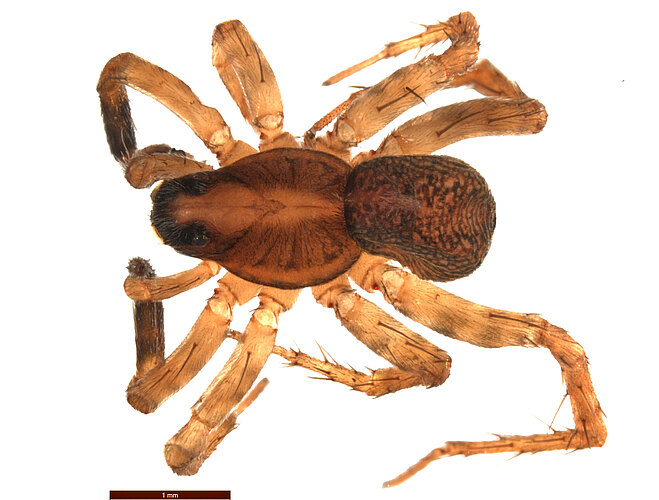Horse Swamp Artoria Artoria equipalus Framenau & Baehr, 2018
Fauna Portal species: 7667Diagnosis
(after Framenau & Baehr 2018): Males of A. equipalus share with A. booderee, A. corowa and A. munmorah a distinctly bi-lobed tegular apophysis, but differ from these by the basal lobe of the tegular apophysis being more sclerotized and oriented more ‘horizontally’ in ventral view. The cymbium tip in A. equipalus has 4–5 macrosetae, which are absent in A. corowa and A. munmorah. Artoria booderee has 2–3 macrosetae on the cymbium tip which is more elongate than that of A. equipalus. The epigyne of female A. equipalus is most similar to that of A. mungo, but the shape of the spermathecal heads is very different in both species with in particular with respect to the insertion of the spermathecal stalks (postero-medial in A. equipalus, lateral in A. mungo).
Status
- native
Linnean Holotype
Australia
- New South Wales
Fauna Portal Records
The map shows all records that have been verified as part of the Fauna Portal project and may not represent the true distribution of a species. Specifically, for described species, check the link to the Atlas of Living Australia on this page for potential wider distributions. Fauna Portal Reference specimens and Linnean types are shown in red. If you identified a specimen that exceeds the distribution of an undescribed species as illustrated here, please contact the Fauna Portal team who can assist with the lodgement of the specimen in a public institution and display on the map.
Similar Species
Publications
Framenau VW, Baehr, BC (2018): The wolf spider genus Artoria in New South Wales and the Australian Capital Territory, Australia (Araneae, Lycosidae, Artoriinae). Evolutionary Systematics. 2: 169 - 241
Araneae (Spiders)
- Actinopodidae
- Anamidae
- Araneae fam. indet.
- Araneidae
- Archaeidae
- Argyronetidae
- Arkyidae
- Barychelidae
- Cheiracanthiidae
- Clubionidae
- Corinnidae
- Cycloctenidae
- Deinopidae
- Desidae
- Dictynidae
- Filistatidae
- Gnaphosidae
- Halonoproctidae
- Hersiliidae
- Idiopidae
- Lamponidae
- Linyphiidae
- Lycosidae
- Allotrochosina
- Anomalosa
- Artoria
- aculeata
- albopedipalpis
- albopilata
- alta
- atrata
- avona
- barringtonensis
- beaury
- belfordensis
- berenice
- bondi
- booderee
- cingulipes
- comleroi
- corowa
- emu
- equipalus
- extraordinaria
- falcata
- flavimana
- FP-11765
- FP-13189
- FP-13237
- gloriosa
- grahammilledgei
- helensmithae
- howquaensis
- impedita
- incrassata
- inversa
- kanangra
- kerewong
- lamellata
- lineata
- linnaei
- maroota
- mckayi
- mungo
- munmorah
- myallensis
- parvula
- pileata
- pinnata
- plicata
- quadrata
- retorta
- schizocoides
- slatyeri
- strepera
- taeniata
- taeniifera
- terania
- triangularis
- trifida
- ulrichi
- victoriensis
- wilkiei
- Artoriopsis
- Costacosa
- Diahogna
- Dingosa
- Genus 2556 (ariadnae grp)
- Genus 3448 (leonhardii gp)
- Genus 3491 (laeta grp)
- Genus 3643 (yalkara grp)
- Hoggicosa
- Hogna
- Kangarosa
- Knoelle
- Kochosa
- Lycosidae gen. indet.
- Mainosa
- Portacosa
- Tapetosa
- Tasmanicosa
- Tetralycosa
- Tuberculosa
- Venator
- Venatrix
- Venonia
- Zoica
- Allotrochosina
- Mimetidae
- Miturgidae
- Mysmenidae
- Nicodamidae
- Oecobiidae
- Oonopidae
- Oxyopidae
- Philodromidae
- Pholcidae
- Pisauridae
- Prodidomidae
- Salticidae
- Scytodidae
- Segestriidae
- Selenopidae
- Sparassidae
- Symphytognathidae
- Tetrablemmidae
- Tetragnathidae
- Theridiidae
- Thomisidae
- Trachelidae
- Trachycosmidae
- Trochanteriidae
- Uloboridae
- Zodariidae
- Zoropsidae
All classes
- Arachnida
- Crustacea
- Entognatha
- Gastropoda
- Insecta
- Blattodea s. str. (Cockroaches)
- Coleoptera (Beetles)
- Dermaptera (earwigs)
- Diptera (flies, mosquitos)
- Entomobryomorpha (slender springtails)
- Hemiptera - Auchenorrhyncha (cicadas, planthoppers)
- Hemiptera - Heteroptera (True Bugs)
- Hemiptera - Sternorrhyncha (aphids, scales etc.)
- Hymenoptera - Formicidae (Ants)
- Hymenoptera excl. Formicidae (bees and wasps)
- Orthoptera - Caelifera (Grasshoppers)
- Trichoptera (Caddisflies)
- Zygentoma (silverfish)
- Myriapoda

